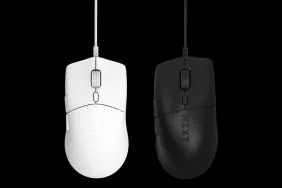Stick and move.
The world of console joysticks is always a little mysterious, since so few games really demand that kind of layout anymore. Hardcore fighting game fans, though, can rarely live without a good stick in their hands. Makes those Hadooken fireballs that much easier.
 Enter Gamester’s Reflex Xbox joystick. As far as home sticks go, this is a fairly decent choice that comes chock full of buttons to push and pound and sticks to screw in. Ahem.
Enter Gamester’s Reflex Xbox joystick. As far as home sticks go, this is a fairly decent choice that comes chock full of buttons to push and pound and sticks to screw in. Ahem.
Enclosed with the Reflex are two joysticks: the ball stick and the peg stick. On the bottom of the Reflex is a detachable hex tool that allows you to screw in your favorite style. I figure the ‘screw-in’ design was conceived initially for cost-effective packaging. Nonetheless, options are always welcome and if some of those savings are passed on to the consumer, who am I to bitch and whine?
The plastic ball portion of the ball stick is slightly smaller than your standard Japanese stick. But those few millimeters render the ball somewhat uncomfortable between the fingers, particularly when you play a game with the palm up. The top half of the ball seems hollow and somewhat cheap.
Personally, I prefer the peg style. The peg has a flat area on the top, creating a comfortable thumb or palm rest. The length of the rod area still makes the joystick less suitable for use between fingers, palm up. I end up resting my hand over the stick, palm down.
The buttons are an amalgamation between the familiar U.S. micro-switch "clicky" buttons and the Japanese-style momentary touch buttons. The buttons have two levels of register – depress it slightly or push it all the way down for click feedback.
The biggest problem with the Reflex is the small button size. The button faces are neither US concave nor Japanese convex, but a compromised flat face. You can get used to them, but they lack the roomier comfort of larger buttons.
The Reflex also comes with the ability to program and store two custom moves, which is nice for those hectic triple-back-flip-dragon-punch-spin-kick-tornado-slaps.
But good luck finding a game worthy of such programming, as currently there’s only one fighting game out on the Xbox. DOA 3 doesn’t allow the left and right analog buttons to be used as straight punches or kicks. This is the game’s fault, though, not the joystick. Depending on how you like your layout, it could mean settling for a three-button control setup. Using A, B, and the black button works fine for me.
The Reflex also works much better on a lap than a table. The curved shape and smaller size make for a good fit across the legs, whereas on a table, the lack of a heavier weighted base causes the stick to shift a bit.
The Reflex is a passable home joystick, though it’s much better suited for small hands. The $35 list price is reasonable, and if you’re fan of fighting games, it’s not a bad investment. Perhaps when more fighting games come out for the Xbox, there will be some more joysticks to test your mettle with.
-
Choice in joystick shape
-
Good in the lap
-
Peg works well
-
Ball too small
-
Buttons too small











